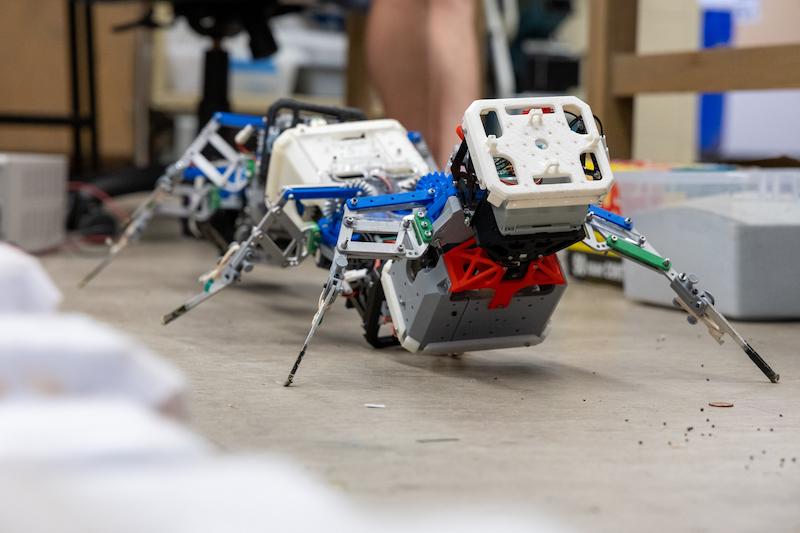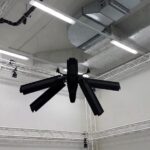2023-05-05 ジョージア工科大学

Centipedes are known for their wiggly walk. With tens to hundreds of legs, they can traverse any terrain without stopping.
◆彼らは、重複する足を持つロボットが、環境を解釈するためのセンサーなしでも不整地を通過できる理論を開発し、多数の足を持つロボットモデルを作成した。
◆この「空間的冗長性」と呼ばれる概念は、ロボットの足が1本故障しても他の足が機能するため、ロボットが信頼性の高い自己輸送システムとなる。同様に、輸送時間を確保するための平穏な環境の整備を行わずに、多数の脚で地形を走行することが可能であるという。
<関連情報>
- https://research.gatech.edu/scurrying-centipedes-inspire-many-legged-robots-can-traverse-difficult-landscapes
- https://www.science.org/doi/10.1126/science.ade4985
- https://www.pnas.org/doi/10.1073/pnas.2213698120
多足歩行による物質輸送: ノイズの多い地形でのロコモーションのためのフレームワーク Multilegged matter transport: A framework for locomotion on noisy landscapes
Baxi Chong,Juntao He,Daniel Soto,Tianyu Wang,Daniel Irvine,Grigoriy Blekherman and Daniel I. Goldman
Science Published:4 May 2023
DOI:https://doi.org/10.1126/science.ade4985
Editor’s summary
Locomotion over rugged terrain, whether human or robotic, generally requires extensive feedback to allow for adjustments in stride to compensate for cracks, inclines, or changes in surface composition. This ability typically requires a network of sensors to detect changes in terrain. Chong et al. show that an alternative approach requiring minimal environmental awareness can guarantee a successful arrival using information theory. The authors draw a parallel between having multiple, connected legs on the robot and having signal transmission protocols that minimize error in transmission—in this case, the “signal” being transmitted is the body of the robot. —Marc S. Levine
Abstract
Whereas the transport of matter by wheeled vehicles or legged robots can be guaranteed in engineered landscapes such as roads or rails, locomotion prediction in complex environments such as collapsed buildings or crop fields remains challenging. Inspired by the principles of information transmission, which allow signals to be reliably transmitted over “noisy” channels, we developed a “matter-transport” framework that demonstrates that noninertial locomotion can be provably generated over noisy rugose landscapes (heterogeneities on the scale of locomotor dimensions). Experiments confirm that sufficient spatial redundancy in the form of serially connected legged robots leads to reliable transport on such terrain without requiring sensing and control. Further analogies from communication theory coupled with advances in gaits (coding) and sensor-based feedback control (error detection and correction) can lead to agile locomotion in complex terradynamic regimes.
スリップによる自己推進力: 多脚式機関車における摩擦泳動 Self-propulsion via slipping: Frictional swimming in multilegged locomotors
Baxi Chong, Juntao He, Shengkai Li, Eva Erickson, Kelimar Diaz, Tianyu Wang, Daniel Soto and Daniel I. Goldman
Proceedings of the National Academy of Sciences Published:March 10, 2023
DOI:https://doi.org/10.1073/pnas.2213698120
Significance
Drag anisotropy is believed to be the critical principle which enables effective undulatory swimming in flowable media. Here, we show that undulatory locomotion with leg retraction/ protraction can be recast as a fluid-like problem with the nonlinearities of foot–ground interactions leading to acquired drag anisotropy. In doing so, our framework allows for the comparison and cross- referencing of undulatory locomotion across diverse substrates. Further, from robophysical and biological experiments, we show that undulatory multilegged frictional swimming can be quantitatively described using a geometric model with low-dimensional centralized control framework. Our analysis not only facilitates the control of robust robot locomotion in complex terradynamic scenarios but also gives insight into neuromechanical control and the evolution of myriapod locomotion.
Abstract
Locomotion is typically studied either in continuous media where bodies and legs experience forces generated by the flowing medium or on solid substrates dominated by friction. In the former, centralized whole-body coordination is believed to facilitate appropriate slipping through the medium for propulsion. In the latter, slip is often assumed minimal and thus avoided via decentralized control schemes. We find in laboratory experiments that terrestrial locomotion of a meter-scale multisegmented/legged robophysical model resembles undulatory fluid swimming. Experiments varying waves of leg stepping and body bending reveal how these parameters result in effective terrestrial locomotion despite seemingly ineffective isotropic frictional contacts. Dissipation dominates over inertial effects in this macroscopic-scaled regime, resulting in essentially geometric locomotion on land akin to microscopic-scale swimming in fluids. Theoretical analysis demonstrates that the high-dimensional multisegmented/legged dynamics can be simplified to a centralized low-dimensional model, which reveals an effective resistive force theory with an acquired viscous drag anisotropy. We extend our low-dimensional, geometric analysis to illustrate how body undulation can aid performance in non–flat obstacle-rich terrains and also use the scheme to quantitatively model how body undulation affects performance of biological centipede locomotion (the desert centipede Scolopendra polymorpha) moving at relatively high speeds (∼0.5 body lengths/sec). Our results could facilitate control of multilegged robots in complex terradynamic scenarios.



